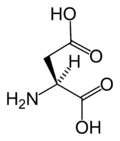L-isomer of aspartic acid is one of the 22 proteinogenic amino acids, i.e., the building blocks of proteins. D-aspartic acid is one of two D-amino acids commonly...
20 KB (1,867 words) - 15:34, 13 August 2024
N-methyl-D-aspartic acid or N-methyl-D-aspartate (NMDA) is an amino acid derivative that acts as a specific agonist at the NMDA receptor mimicking the...
12 KB (988 words) - 20:01, 15 August 2024
Aspartame (category Amino acid derivatives)
sugar substitute in foods and beverages. It is a methyl ester of the aspartic acid/phenylalanine dipeptide with brand names NutraSweet, Equal, and Canderel...
61 KB (5,656 words) - 19:27, 31 October 2024
site and are optimally active at acidic pH. Nearly all known aspartyl proteases are inhibited by pepstatin. Aspartic endopeptidases EC 3.4.23. of vertebrate...
10 KB (999 words) - 06:14, 23 February 2023
Polyaspartic acid (PASA) is a biodegradable, water-soluble condensation polymer based on the amino acid aspartic acid. It is a biodegradable replacement...
17 KB (1,724 words) - 20:18, 2 December 2023
amino acids. The aspartate pathway uses L-aspartic acid as the precursor for the biosynthesis of one-fourth of the building block amino acids. The biosynthesis...
31 KB (3,929 words) - 13:49, 28 June 2024
NMDA receptor (redirect from N-methyl-D-aspartic acid receptor)
receptor agonists include: Amino acids and amino acid derivatives Aspartic acid (aspartate) (D-aspartic acid, L-aspartic acid) – endogenous glutamate site...
107 KB (12,058 words) - 11:59, 2 November 2024
Asparagine (redirect from Amino acid N)
asparagine and aspartic acid itself are decomposed with a remarkable ease under the influence of nitrous acid, rendering nitrogen gas and malic acid.) Plimmer...
21 KB (1,929 words) - 14:38, 30 August 2024
aspartic acid, asparagine, glutamic acid, serine, and selenocysteine (considered the 21st amino acid). Pyrrolysine (considered the 22nd amino acid),...
27 KB (2,690 words) - 10:20, 3 September 2024
Carbamoyl aspartic acid (or ureidosuccinic acid) is a carbamate derivative, serving as an intermediate in pyrimidine biosynthesis. "ureidosuccinic acid - Compound...
3 KB (40 words) - 05:39, 18 August 2020
N-Acetylaspartic acid, or N-acetylaspartate (NAA), is a derivative of aspartic acid with a formula of C6H9NO5 and a molecular weight of 175.139. NAA is...
9 KB (745 words) - 23:35, 26 April 2024
EDDS (redirect from Ethylenediaminedisuccinic acid)
acid or maleic acid, which proceeds as follows: (S,S)-EDDS is produced stereospecifically by the alkylation of an ethylenedibromide with L-aspartic acid...
11 KB (996 words) - 10:00, 22 February 2024
L-Arginine (Arg / R) L-Asparagine (Asn / N) L-Aspartic acid (Asp / D) L-Cysteine (Cys / C) L-Glutamic acid (Glu / E) L-Glutamine (Gln / Q) Glycine (Gly / G)...
38 KB (1,631 words) - 14:51, 30 August 2024
binding properties and prevents degradation at the highly susceptible aspartic acid residue, thereby increasing their stability. Many RGD derivative drugs...
36 KB (3,744 words) - 15:44, 15 March 2024
PubChem — racemic ^a CID 83887 from PubChem — (D-aspartic acid) ^a CID 5960 from PubChem — (L-aspartic acid) ^a CID 450566 from PubChem — C(C(C(=O)O)N)[11C](=O)O...
3 KB (70 words) - 11:39, 12 April 2023
Tetrasodium iminodisuccinate (category Salts of carboxylic acids)
a sodium salt of iminodisuccinic acid, also referred to as N-(1,2-dicarboxyethyl)aspartic acid. Iminodisuccinic acid can be prepared by reacting maleic...
9 KB (835 words) - 00:06, 9 January 2024
also arise from trans- or de- amination of aspartic acid. Oxaloacetate is an intermediate of the citric acid cycle, where it reacts with acetyl-CoA to...
12 KB (1,159 words) - 10:09, 7 July 2024
Protein metabolism (redirect from Amino acid metabolism)
main amino acids involved are serine, histidine, and aspartic acid. They all play a role in cleaving the peptide bond. These three amino acids are known...
27 KB (2,828 words) - 23:11, 3 November 2024
dicarboxylic acid in the industry is adipic acid, which is a precursor in the production of nylon. Other examples of dicarboxylic acids include aspartic acid and...
37 KB (3,151 words) - 17:51, 13 October 2024
; Little, Peter J.; Blakey, Idriss; Ta, Hang T. (2021-06-14). "Poly(aspartic acid) in Biomedical Applications: From Polymerization, Modification, Properties...
42 KB (4,375 words) - 05:33, 21 October 2024
GADV-protein world hypothesis (category Amino acids)
GADV stands for the one letter codes of four amino acids, namely, glycine (G), alanine (A), aspartic acid (D) and valine (V), the main components of GADV...
4 KB (449 words) - 12:55, 27 September 2024
acids are: Alanine Arginine Asparagine Aspartic acid Cysteine Glutamic acid Glutamine Glycine Histidine Methionine Proline Serine Valine Amino acids that...
5 KB (520 words) - 15:37, 29 April 2024
Alanine transaminase (redirect from Small amino acid synthesis)
pyridoxamine in the first phase of the reaction, when an amino acid is converted into a keto acid. ALT is commonly measured clinically as part of liver function...
13 KB (1,370 words) - 19:23, 21 September 2024
Aspartylglucosamine (category Amino acid derivatives)
Aspartylglucosamine is a derivative of aspartic acid. Levels are elevated in aspartylglucosaminuria. PubChem. "N-aspartylglucosamine". pubchem.ncbi.nlm...
2 KB (27 words) - 15:51, 17 September 2023
amino acid, which has been shown to be involved in ATP binding. In the central part of the catalytic domain, there is a conserved aspartic acid, which...
15 KB (1,635 words) - 23:25, 13 August 2024
mainly provided by acidic amino acids including aspartic acid (pKa=3.9) and glutamic acid (pKa=4.2). The charges of acidic amino acids will change with...
30 KB (3,427 words) - 11:43, 28 September 2024
environments, like the aspartic protease pepsin in mammalian stomachs, may have catalytic aspartate or glutamate residues that act as Brønsted acids. There are three...
98 KB (10,151 words) - 03:53, 21 October 2024
measure up to 9 amino acids useful in geochronology over different time scales on a single chromatogram (aspartic acid, glutamic acid, serine, alanine, arginine...
15 KB (1,778 words) - 11:37, 4 April 2024
biochemistry, non-coded or non-proteinogenic amino acids are distinct from the 22 proteinogenic amino acids (21 in eukaryotes), which are naturally encoded...
27 KB (2,864 words) - 19:08, 10 October 2024
each amino acid. This letter system was defined by the IUPAC and IUBMB in 1983, and is as follows: K—Lysine D—Aspartic acid E—Glutamic acid L—Leucine Therefore...
9 KB (1,104 words) - 16:43, 14 August 2023
























